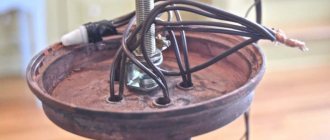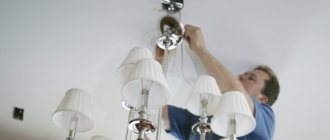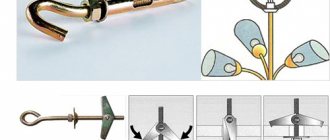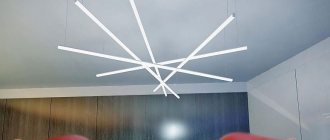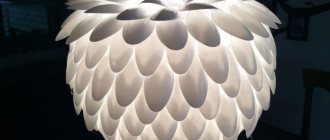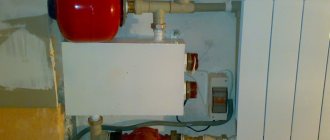A chandelier is a favorite and main lighting fixture in most apartments. The varieties and varied designs make it universal, suitable for any style and size of room. Installing a chandelier is a rather complicated process that is best left to specialists. If you are “your own master,” then we hope our article will help you understand the basic principles and details of this operation.
Types of chandelier mounting
As we know, there are two types of chandeliers - ceiling and pendant. They differ in appearance and in the method of attachment. A pendant chandelier is more difficult to install. There are only three mounting methods:
- using a hook;
- mounting on a bar;
- mounting on a bracket.
A chandelier will delight you with its light and decorate the room only if it is securely fastened and connected correctly. Therefore, we devoted this article to practical issues of installing and connecting a chandelier, and we will try to understand the technology of each method.
Installation of fasteners and installation of the lamp
Then everything happens in exactly the same way as in the case of traditional floors. With only one difference - the screws are screwed into the base through holes made in the ceiling fabric.
The mounting plate or strip is fixed to the prepared base through holes pre-reinforced with overlays in the stretched fabric or film.
The lamp itself is suspended from it and fixed in place with decorative nuts. This completes the installation of the chandelier in the suspended ceiling.
Important: if LED lighting is planned, the transformer unit should not be mounted in the space above the tensioned covering. It can get quite hot. It is better to take it outside this space and install it in any suitable niche outside.
Features of mounting a chandelier on a hook
Depending on the weight of the chandelier, different types of fasteners are selected. The hook is considered the simplest and most reliable option. It is always screwed into a solid base - concrete or wood. The choice of fastening also depends on the type of ceiling covering. The following types of hooks exist:
- Anchor - a hole is drilled for it, in which it is fixed by surprise. Mainly used for concrete ceilings.
- Through - even at the stage of building a house, the hook is installed through the ceiling and securely fastened.
- Mortgage – fixed in a concrete slab if there are voids there.
- Simple hook with thread, self-tapping screw.
The type, type and size of the mount depend on the weight of the lighting fixture. Typically, installation parameters are indicated on the packaging of the chandelier. However, the hook is usually not included in the kit, which means you need to purchase it yourself. And here there are certain rules:
- If the weight of the chandelier does not exceed 4 kilograms, then installation can be carried out using a regular threaded hook. To do this, just drill a hole in the ceiling, place a plastic dowel in the channel, and then screw in the hook as deeply and tightly as possible.
- If the weight of the lamp exceeds 4 kg, then an anchor option will be required. Such a hook is a whole structure consisting of a spacer sleeve, which, in fact, ensures reliable installation by expanding in the drilled hole; threads and nuts, which ensures the convenience of screwing the thread. When screwed in, the spacer sleeve expands and is securely fixed in the concrete base.
After installing the hook, electrical power is supplied to it. The main advantages of such fastening:
- The most reliable method allows you to attach the chandelier to a suspended ceiling. Special high-strength hooks can withstand very massive models.
- It is possible to change the lighting device if it is out of order, or you have started repairs - there can be a lot of reasons. Just remove it from the hook. When attaching to the bar, you will have to unscrew a lot of things.
The main drawback is that this option is not suitable for low ceilings.
Types of fastening and work
Securing with a mounting strip
The mounting strip is used to strengthen the place where you plan to hang the device.
The chandelier is installed using a device on concrete ceilings covered with sheets of plasterboard. This finish is not designed to withstand the impact of large masses, so the future location of the device should be strengthened. Based on the size of the fastening elements, the profiles are laid in a special way - parallel to each other, in a square or rectangular shape.
Next, perform the following steps:
- Surface preparation. Place the plank on the ceiling; it should be in close contact with it. If there are any irregularities, they are sealed with putty painted in the same color as the decor of the main surface.
- Checking the wiring. The condition of the wires from the power supply is analyzed.
- The presence of the old fastening element is checked. If there is a hook left, it is carefully bent or cut off.
- Surface marking. The bracket is reattached, marks are made with a pencil in the place of future holes, or a recess is knocked out with a punch.
- Drilling concrete. Use an electric drill or hammer drill with a Pobedit drill to drill holes of the required depth. In this case, you need to take into account the length and diameter of the dowel.
- Installation of the plank. The dowels are driven into the holes, and fasteners are mounted to them using self-tapping screws or special screws.
- Checking the reliability of fastening. The strength of the fixed device is analyzed.
- Electrical connection. The chandelier is connected to the wiring.
Hook mounting
Installing a hook involves drilling a hole into which you need to insert a dowel and screw the device.
A more complicated type of fastening a lamp to a monolithic ceiling is a threaded hook. Used to install light weight chandeliers (from 3 to 4 kg), you can use it to hang a picture on the wall. To install the mount, follow these simple steps:
- Drill a hole in the selected location and hammer a secure dowel into it.
- Screw in the hook.
Before installing the fastener, a special gypsum solution is prepared to seal the hole; its consistency should be similar to thick sour cream. Using a wood chip, the mixture is pushed into the hole. This product hardens quickly, so the hook and collet are immediately installed in place, and the remaining plaster is removed. To secure the fastener, you can install a pin in the dowel and then tighten the hook. The final maturation of the solution will occur in 2 hours, and then they begin to install the light source.
Installation on an anchor
Used to secure chandeliers weighing more than 5 kg. Therefore, this type of fastener is suitable for concrete floor ceilings that can withstand heavy daylight fixtures. Using a drill or hammer drill equipped with a drill with a pobedit tip, make a hole of the required size. The anchor dowel is equipped with a spacer device, which, after installing the hook and tightening the fixing nut, diverges to the sides and is firmly fixed to the concrete.
A special bowl on the chandelier will help hide fasteners and wiring.
This product has an unaesthetic appearance, which spoils the appearance of the design of the ceilings. To hide the fastening element and the electrical wires that go to the chandelier, the lighting fixture is equipped with a special bowl that covers the “insides” of the fastening structure. The main quality of this type of metal fastening is strength and reliability.
On a hanging bracket
The mounting strip and fastening elements are included with the lighting device. For structural strength, it is advisable to separately purchase reinforced dowels. The hole for the bracket holes is marked on the ceiling with a pencil. It is advisable to punch these marks with a punch, hitting it with a hammer - then it will be easier to drill. Before installation, bolts are screwed into the bracket to hold the chandelier. Next, the concrete is drilled, dowels are installed, and the plank is secured to the ceiling with self-tapping screws. Then they begin to connect the wires and directly install the device.
Attaching the chandelier to the bar
The mounting strip is included with the chandelier. Special plates that are fixed to the ceiling with self-tapping screws come in three varieties:
- For small devices, conventional longitudinal ones are used.
- Cross-shaped - if the weight of the chandelier is significant.
- For the heaviest and most massive ones, I-beams are used.
Sequence of installation operations:
- First, mark with a pencil the intended location for attaching the chandelier.
- Use a drill or hammer drill to make holes for fastening.
- We insert plastic dowels into the holes.
- The plank is applied in such a way that the holes on it coincide with the dowels, then we screw the plank.
- We fix the chandelier on the bar, connect the wires.
- Tighten all existing nuts.
You won’t be able to do this alone, since you have to hold the chandelier and connect the wires at the same time. This method is often used when installing on a suspended ceiling.
Pros and cons of main light sources
- Incandescent lamps - the lowest cost is compensated by an unrealistically low efficiency. Most of the absorbed energy simply heats the surrounding area. Therefore, such lamps are limited to a power not exceeding 60 watts. The minimum distance to the ceiling must be at least 25 cm, which is not always technically possible.
- The efficiency of halogen lamps is only slightly higher than that of incandescent lamps. However, the halogen environment allows you to significantly increase the temperature of the coil. The spectrum of these lamps is most identical to ordinary daylight. However, due to the increased temperature of the flask, the power limit is 35 watts.
- Energy-saving lamps have a relatively high efficiency and heat up quite slightly. All heating occurs mainly under the influence of the power converter. Restrictions relate to high room humidity, since dampness negatively affects the operation of the power converter. Insignificant heat generation allows such lamps to be installed as close to the ceiling surface as possible.
- The best option is chandeliers with LED lamps. They have maximum efficiency, minimal heat generation and a huge life cycle, regardless of switching on and off. Beam direction does not require reflectors. The only limitation is to remove the power supply from under the suspended ceiling to avoid overheating and failure.
Mounting a chandelier on a bracket
The chandelier is mounted on the bracket using the same technology as on the bar. You will just have to drill more holes, since the bracket consists of several crossed strips. It is required when the chandelier is very massive and heavy. The bracket is also included in the package. In this case, several holes are made in the ceiling, so careful preliminary marking is necessary. Installation consists of two stages: securely attaching the bracket to the ceiling and attaching the chandelier itself.
Mandatory preparatory activities
In order to cope with the task and do everything correctly, you need to prepare the tools so that during the process of installing the chandelier on the ceiling nothing distracts the master:
- you need a stepladder of sufficient height (you can get by with a table);
- hand-held electric drill or hammer drill;
- pliers and wire cutters or side cutters (from electric shock, handles must be insulated);
- various screwdrivers (including with indicator function);
- a roll of electrical tape;
- several mounting blocks (with a reserve) for wire clamps;
- the necessary fasteners on which the chandelier will be installed on the ceiling.
Before fixing the ceiling chandelier, be sure to read the instructions for connecting it to the electrical network. Usually it gives a detailed description of all operations, so a master who knows a little about electricity should not have any particular difficulties.
How to attach a chandelier?
During installation, it is necessary that the lighting device is not only securely fastened, but also does not damage the ceiling covering. The fasteners included with the chandelier will not always be suitable for your ceiling. Therefore, we analyze it in detail.
- Wooden ceiling - this is the easiest place to strengthen a chandelier. We mark the surface, make holes, screw a bar or hook (you can use a self-tapping hook with a thread), connect power and hang the lighting fixture.
- Concrete ceiling - this will require some work. We choose an anchor hook for this purpose - it, as a rule, is not included in the chandelier package. We fix it in the ceiling, as described above, that is, we drill a hole so that the hook fits into it as tightly as possible - choose the correct diameter of the drill, and the depth of the hole exactly matches the length of the hook. When drilling, to prevent dust from flying into your eyes, craftsmen advise putting a plastic or paper cup over the drill. We connect the wires and carefully place them inside the decorative bowl. We check the strength by hanging a load heavier than the chandelier.
- Stretch ceiling - fixed either with a hook or on a strip. All preliminary work is carried out before installation of the structure. A hole is made for the hook, a chain for the chandelier is attached to it, and the cut hole is covered with a bowl. When mounting on a bar, the algorithm is slightly different. The strip is fixed on a wooden base - bars equal to or exceeding the width of the strip, so that it does not overlap or pinch suitable wires. Then they install the suspended ceiling and mark the place where the strip is fixed, glue a special plastic ring in the center, cut a hole inside, take out the wires and attach it to the lamp.
- Plasterboard (suspended) ceiling. It is located at some distance from the ceiling and installation of the lamp has its own characteristics and difficulties. The most desirable method of fastening is on a hook. To do this, mark the location of the lighting fixture on the ceiling, where an anchor hook is inserted, around which the frame is mounted, leaving a hole for the hook. The ceiling chandelier is attached using a strip, to which a timber base is created. The bar is fixed to the base, and then the lamp is attached to it.
Installation with ceiling hook
Typically, a hook for securing lighting fixtures is installed during construction work. In this case, before hanging the chandelier on the ceiling, you need to check its strength.
Mounting hook
To check, for some time a load corresponding to the weight of or slightly heavier than the chandelier is suspended from the installed hook. If the attached load has not shifted, you can safely hang the chandelier in place. If the fastening hook has moved, or even fallen out, you can carry out the installation work yourself.
Testing the hook with the weight of a chandelier
To do this you need:
- use a puncher to make the required hole (if it does not already exist);
- a properly selected metal anchor or a folding spring dowel with a ring is inserted into it. It should fit snugly against the inner surface of the drilled hole;
- It is enough to screw a strong self-tapping hook into a wooden ceiling.
Read: DIY ceiling lighting
This is the simplest method that describes how to attach a chandelier to the ceiling.
Schematic mounting of the holding element
If the ceiling is finished with plasterboard or a tension fabric is installed, the work of attaching the chandelier to the hook may become more complicated.
Plasterboard sheets are quite durable, so a small lamp can be mounted directly onto the material itself, but it is worth considering small nuances:
- the weight of the attached lighting device should not exceed 6 kg;
- It is worth paying attention to the fact that when replacing lamps, you can damage the sheets or accidentally touch a low-hanging lamp with your hand.
Therefore, when installing a ceiling made of plasterboard sheets, it is necessary to think in advance about the lighting of the room and make a hole in the material under the mounted hook.
If this has not been done, then you can hang the chandelier on a spring dowel or a special butterfly installed in a drilled hole. The dowel will need to be tightened with a special nut, and the butterfly spacer will need to be tightened with a self-tapping screw until it clicks. All fasteners must be equipped with a pin or hook to which the chandelier is attached.
One of the options for mounting a chandelier if the ceiling is made of plasterboard
When installing a stretch ceiling, you must take care in advance of how to secure the lamp. It must be remembered that a stretched canvas cannot serve as a fastening base for a chandelier. When installing a suspended ceiling, workers, before cutting a hole for attaching a lamp, glue a thermal ring in advance. If this is not done, then it will be impossible to hang the chandelier from the ceiling, since the stretched fabric will tear. Connecting wires are routed through the cut hole.
With this option, you first need to hang the chandelier on a hook, and then connect the electrical wires, after which the attachment point is covered with a decorative cap of the lamp.
Mounting diagram for suspended ceiling
Video instructions for installing a chandelier on a hook
Safety precautions at work
Of course, we deliberately omit purely technical terms here to make things easier to understand. For more detailed instructions on installing a chandelier, we address you to professionals, and we will now touch on safety issues that must be observed when performing electrical work.
- Just turning off the lights is not enough; turn off the power to the apartment by turning the circuit breakers on the distribution panel to the “off” position. If you have an old electric meter and no panel, then simply remove the plugs.
- Check the wiring, and it is better if a specialist does it.
- Make sure there is no voltage on the wires using an indicator device. It has either phase or zero. If there is voltage, the device will show the phase.
- Connect the wires using terminals or blocks. Simple twisting is extremely unreliable.
- Choose only high quality consumables, both your safety and the reliability of the system depend on it.
- All installation tools must be in good working order.
- If you are installing lamps in a damp room (bathroom), then be especially careful.
- Copper and aluminum wires cannot be twisted together - only using terminal blocks with separate clamps for each wire.
- Do not neglect grounding, although this will complicate the work.
And most importantly: do not touch the wires without disconnecting them from the network.
Criteria for selecting lighting fixtures
When choosing lighting fixtures for a stretch ceiling, you should take into account the features of its design
When selecting a lamp, several features should be taken into account:
- When choosing a base for a ceiling chandelier, you should not purchase a design with a metal base so that the ceiling is not subject to heating.
- To prevent damage to the ceiling, it is important to ensure that there are no sharp elements pointing upward on the chandelier.
- The location of the lamps from the canvas should be 35-40 cm.
- It is recommended to give preference to models with several light bulbs with low power.
When choosing a chandelier for a room with a high ceiling, it is worth purchasing a model with several tiers.
Installation instructions for the chandelier
We are armed with knowledge about the types of fastening of chandeliers, about how to install them on different types of ceilings, is it time to get to work? We will need:
- Stepladder - how else to do work under the ceiling. Don't have a stepladder? You can get by with a table, but only if the ceiling does not exceed 2.5 meters. Of course, the table must be reliable and strong.
- An electric drill or hammer drill, but they must be powered by a battery, not from the mains - you will turn off the electricity.
- A screwdriver, also battery powered.
- Several different screwdrivers, flat and Phillips, an indicator screwdriver for checking the voltage in the wires.
- A device for measuring electrical voltage, called a multimeter.
- A knife for stripping wires must be sharp.
- Soldering iron and solder.
All consumables and mounting tools are usually included with the chandelier. And you will probably need an assistant to carry tools when you are near the ceiling and hold the chandelier.
And finally, a few more very important recommendations:
- Make all connections and connections in strict accordance with the diagram specified in the instructions for the electrical device.
- Wrap the exposed parts of the wires in several layers of electrical tape.
- Do not use random supports when working: no boxes or crates, this is very dangerous. Only a reliable stepladder with a latitude limiter.
- All tools must be in good working order and not slip out of your hands.
- When drilling holes, be sure to ensure that no wiring is running through there. Use a sound locator for this.
- Pay attention to the switches; if they are not connected correctly, you may get an electric shock when connected.
Hanging a chandelier yourself is difficult, but it is possible. The main thing is to approach this issue responsibly and seriously. Follow the strict sequence of work and follow the instructions. Electrical work is associated with increased danger. Wear goggles over your eyes and rubber gloves on your hands.
Phasing
If there are no color markings on the wires, you will need an electrical device to recognize them. It is called a phase indicator and shows its presence at the end of the wire. It has an external resemblance to a screwdriver.
Such a device consists of several parts, which are:
- housing made of insulating material;
- metal conductive tip;
- depending on the model, electronic display or signal LED;
- button or metal terminal.
Using an indicator screwdriver, the presence of voltage is determined as follows: it is held with the right hand between the thumb and middle finger, and the index finger is placed on the metal terminal.
You need to touch all the wires one by one with the sting. When contact with the phase wire with voltage is made, the corresponding icon will appear on the display or the LED will light up. Phase search using an indicator is performed exclusively with one hand.
Phasing is done step by step:
- First of all, they de-energize the room, for which it is enough to unscrew the plugs or turn off the machine in the panel. In addition, turn off the switch going to the lamp. The old device is removed, and if this was done earlier and its ends are already insulated, freed from the insulating tape. Using an indicator screwdriver, make sure there is no phase on each wire one by one. If necessary, strip the insulation so as to free approximately one centimeter of the metal core. The wires should be spread apart - they should not touch each other.
- Turn on the machine on the panel, as well as the lamp switch. An indicator screwdriver is used to touch the exposed part of the wires to determine the phase and neutral wire. To make it convenient, mark the neutral conductor with a marker, a piece of electrical tape, or bend it. When three wires are brought out of the ceiling, and there is a two-key switch on the wall, first of all, turn on both keys, find the neutral and two phase wires and mark them. Then one of the keys is turned off to see that there is no phase on one wire. Next, turn off the second key to make sure there is no voltage on the other wire. In this case, you can connect the chandelier according to a two-stage diagram. If there is no indicator, use a multimeter instead, for which it is switched to the AC voltage measurement mode.
- At the next stage, they are looking for the place where the wiring is laid in the ceiling. This is done so as not to damage the wires when the strip for placing the chandelier is attached. For a non-contact method of determining the phase, an electronic indicator will be required. They hold it in their hand, turn on the switch and begin to move it at a short distance from the ceiling in the place where the plank is planned to be attached. When a phase wire is found, a phase sign will appear on the display. The device is carried back and forth several times, marking the boundaries where it detects the phase. As a result, the location of the cable is determined, which means the place where you should not drill. Turn off the switch and machine. Then they begin the next stage of preparation.
Types of suspensions
Ceiling lights can vary greatly in shape, size, material, number of lamps and weight. Therefore, before attaching the chandelier to the ceiling, select the right hook and pay attention to its load-bearing capacity.
Mounting hook
It consists of two parts, fastened together in the shape of the letter T. The chandelier is suspended from one side, the other is inserted into the hole in the ceiling and holds the hook, resting on the edges of the hole. The first part is a bar with a half-ring at one end and holes for height adjustment at the other. The second part can be either a strip or a piece of thick steel wire.
Through hook B 16/240.
The mounting hook does not firmly fix and does not adhere tightly to the floor slab. The hole into which the fixture hanger for the lamp and the cable for connecting the power comes out is quite large. It is closed with a decorative white plastic plug in the form of a lid. Often such fastenings are installed in new buildings, but after the house is put into operation, apartment owners remove them during cosmetic repairs, since they do not ensure a tight and neat fit of the ceiling lamp to the painted surface of the ceiling, due to the presence of a plug.
